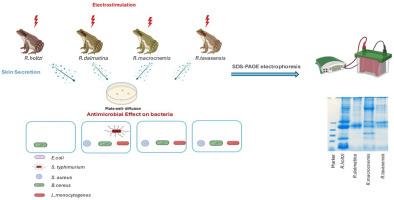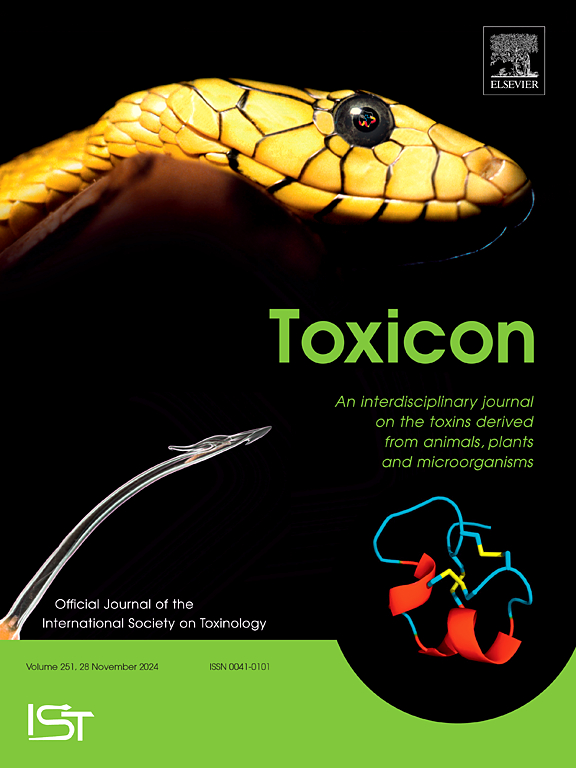Comparative analysis of protein profiles in skin secretions of some Rana species: Preliminary insights into antimicrobial activity
IF 2.6
4区 医学
Q2 PHARMACOLOGY & PHARMACY
引用次数: 0
Abstract
Protein profiles of skin secretions of Rana dalmatina (Agile Frog), Rana macrocnemis (Uludağ Frog), Rana tavasensis (Tavas Frog) and Rana holtzi (Taurus Frog) frog species belonging to the Rana genus distributed in the Anatolian region of Türkiye were determined for the first time using the Tricine-SDS-PAGE Electrophoresis method and Coomassie Brilliant Blue (CBB) staining. By the results, some peptides with mass ≤5 kDa were detected. Just one peptide with mass ≤5 kDa was found in the secretion of each R. dalmatina, R. macrocnemis, and R. tavasensis while there was two in R. holtzi secretion. The antibacterial activity of secretions was determined using plate well diffusion assay on E. coli, S. typhimurium, S. aureus, B. cereus and L. monocytogenes bacteria. R. dalmatina created the inhibition zone for S. typhimurium, S. aureus, B. cereus, and L. monocytogenes. The zones of inhibition by R. tavasensis and R. macrocnemis species secretions were observed on S. aureus, B. cereus, and L. monocytogenes. It was found that R. holtzi creates an inhibition zone only on B. cereus. The results showed that the secretion of none of the species doesn't have antibacterial activity on E. coli. The skin secretion of R. dalmatina showed the most activity against bacteria, while R. holtzi had the least.

一些蕉属物种皮肤分泌物中蛋白质谱的比较分析:对抗菌活性的初步认识
采用 Tricine-SDS-PAGE 电泳法和 Coomassie Brilliant Blue (CBB) 染色法,首次测定了分布在土耳其安纳托利亚地区的蛙属物种 Rana dalmatina (Agile Frog)、Rana macrocnemis (Uludağ Frog)、Rana tavasensis (Tavas Frog) 和 Rana holtzi (Taurus Frog) 皮肤分泌物的蛋白质谱。结果发现了一些质量小于 5 kDa 的肽。dalmatina、R. macrocnemis和R. tavasensis的分泌物中都只有一个质量≤5 kDa的肽,而R. holtzi的分泌物中有两个。分泌物的抗菌活性是通过对大肠杆菌、鼠伤寒杆菌、金黄色葡萄球菌、蜡样芽孢杆菌和单核细胞增多性乳酸杆菌进行板孔扩散试验来确定的。R. dalmatina 对伤寒杆菌、金黄色葡萄球菌、蜡样芽孢杆菌和单核细胞增生性酵母菌产生了抑制区。R. tavasensis 和 R. macrocnemis 的分泌物对金黄色葡萄球菌、蜡样芽孢杆菌和单核细胞增生梭状芽孢杆菌均有抑制作用。结果发现,R. holtzi 只对蜡样芽孢杆菌产生抑制区。结果表明,没有一个物种的分泌物对大肠杆菌没有抗菌活性。R. dalmatina 的皮肤分泌物对细菌的活性最高,而 R. holtzi 的活性最低。
本文章由计算机程序翻译,如有差异,请以英文原文为准。
求助全文
约1分钟内获得全文
求助全文
来源期刊

Toxicon
医学-毒理学
CiteScore
4.80
自引率
10.70%
发文量
358
审稿时长
68 days
期刊介绍:
Toxicon has an open access mirror Toxicon: X, sharing the same aims and scope, editorial team, submission system and rigorous peer review. An introductory offer Toxicon: X - full waiver of the Open Access fee.
Toxicon''s "aims and scope" are to publish:
-articles containing the results of original research on problems related to toxins derived from animals, plants and microorganisms
-papers on novel findings related to the chemical, pharmacological, toxicological, and immunological properties of natural toxins
-molecular biological studies of toxins and other genes from poisonous and venomous organisms that advance understanding of the role or function of toxins
-clinical observations on poisoning and envenoming where a new therapeutic principle has been proposed or a decidedly superior clinical result has been obtained.
-material on the use of toxins as tools in studying biological processes and material on subjects related to venom and antivenom problems.
-articles on the translational application of toxins, for example as drugs and insecticides
-epidemiological studies on envenoming or poisoning, so long as they highlight a previously unrecognised medical problem or provide insight into the prevention or medical treatment of envenoming or poisoning. Retrospective surveys of hospital records, especially those lacking species identification, will not be considered for publication. Properly designed prospective community-based surveys are strongly encouraged.
-articles describing well-known activities of venoms, such as antibacterial, anticancer, and analgesic activities of arachnid venoms, without any attempt to define the mechanism of action or purify the active component, will not be considered for publication in Toxicon.
-review articles on problems related to toxinology.
To encourage the exchange of ideas, sections of the journal may be devoted to Short Communications, Letters to the Editor and activities of the affiliated societies.
 求助内容:
求助内容: 应助结果提醒方式:
应助结果提醒方式:


